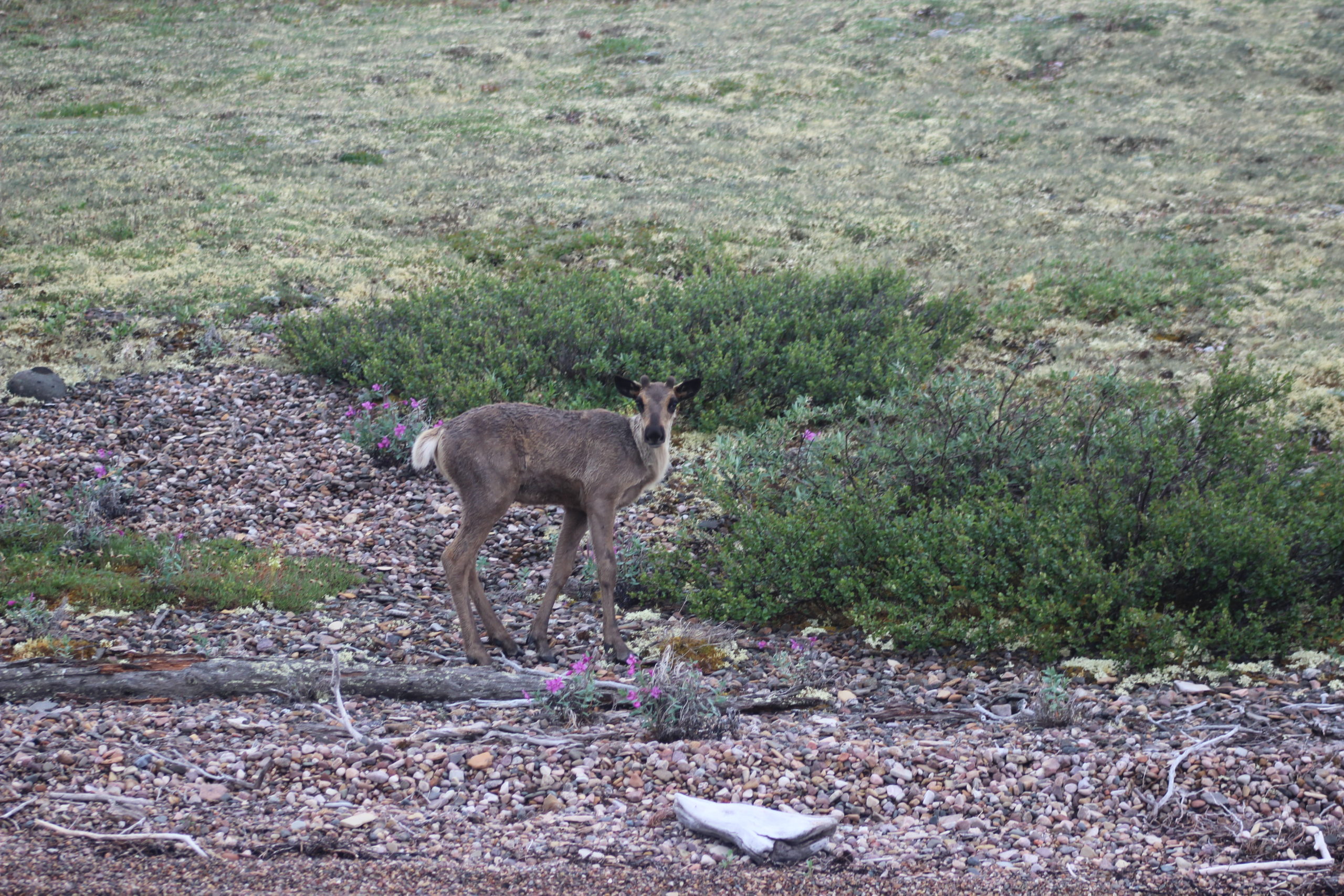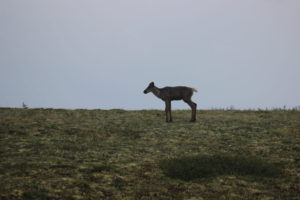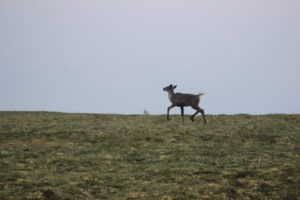Boreal Caribou

Biology
Boreal caribou are one of two populations of woodland caribou (Rangifer tarandus caribou) in the NWT, they differentiate from mountain woodland caribou in general morphology and habitat use. They are dark brown in colour in the summer and grey in the winter. Their shoulders, neck, mane, underbelly and under-side of their tail are creamy-white. They weigh 110-210 kg and their height at shoulder is 1-1.2m. Compared to barren-ground caribou, they are often larger and darker, have a longer face, have longer legs and have thicker and bigger antlers. Females usually begin reproducing at three years of age and have one calf a season. On average, only half of calves born will survive past six weeks of age due to predation. Large hooves and long legs allow them to cross snow and muskegs efficiently. They have been called the “grey ghosts of the forest” because they are able to move quietly throughout the forest individually or in small family groups blending into their surroundings.
Habitat
The population is estimated at 6,000 to 7,000 and occupies diverse habitat across a continuous NWT range. This includes boreal forest east of the Mackenzie Mountains north to Tuktoyaktuk, south to northern Alberta and northern BC, and to the edges of the treeline. They prefer mature spruce forests that have lichen readily available. In the summer they also utilize ridges, river edges, islands, swamps, meadows and burned areas. Their food is thought to be predominantly lichen, but also includes willow leaves, sedges, tree buds, grasses, mushrooms, shrubs and aquatic vegetation. When calving, the females distance themselves and spread out individually along their range in an attempt to avoid predators, a vast, intact landscape provides a best chance for boreal caribou to successfully reproduce and for calf survival. While they do not complete vast migrations in large groups like barren ground caribou, they will often find habitat they prefer seasonally and venture between areas. Seasonal movements can take place across regional and provincial/territorial political borders and outside of protected areas. Planning for habitat connectivity where conservation or development is being considered is critical to maintaining the current population across the NWT.
Ecological and Cultural Significance
Boreal caribou are an indicator of broader ecosystem integrity, population trends can be a bellwether for the health of the boreal forest and the biodiversity within it.
Current Listing/Threats
Boreal caribou are listed as threatened by the NWT List of Species at Risk and are also listed as threatened by the Federal Species at Risk Act. A Boreal Caribou Recovery Strategy has been created. This requires that there be at least 65% of undisturbed habitat within the NWT range. Boreal caribou’s habitat is being altered and threatened by industrial activity such as oil and gas development, logging, mining, and by linear disturbances associated with such activity. This is especially prevalent in southern NWT, northern Alberta and northern BC. Linear disturbances also increase access of predators into boreal caribous range that may have previously not been a large threat. Fires are increasing in these areas which also leads to habitat destruction and alteration. If they are not able to freely travel over borders between their seasonal habitat, or within the boreal forest to avoid predators, the consequences for their population can be devastating. Boreal caribou also do not like noise, and will flee if disturbed too much by vehicles, or snowmobiles. This requires an unnecessary utilization of energy that could be better spent avoiding predators.
Resources
- CPAWS 2016 Caribou Report
- Recovery Strategy for the Boreal Caribou (Rangifer tarandus caribou) in the Northwest Territories (2017)
- CPAWS-NWT Boreal Caribou Poster
- Gwich’in Renewable Resources Board
- NWT Species at Risk
- Sahtú Renewable Resources Board (Ɂehdzo Got’ı̨nę Gots’ę́ Nákedı)
- The Wekʼèezhìi Renewable Resources Board
- Government of Northwest Territories- Environment and Natural Resources
- COSEWIC Assessment and Update Status Report
- Caribou Quarterly- Updates on Boreal Caribou Range Planning in the NWT
![CPAWS NWT Logo [Transparent Background] CPAWS NWT](https://cpawsnwt.org/wp-content/uploads/2018/09/CPAWS-NWT-Logo-Transparent-Background.png)



